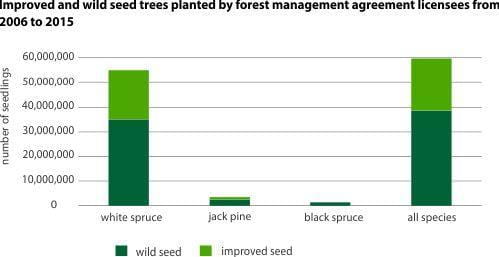
Genetic diversity is important for maintaining commercially or culturally important traits of tree species. Genetic variation is required for long-term species survival and evolution.
What's happening

What we are doing
An important part of forest regeneration is the genetic diversity of the seeds used to renew the forest in Saskatchewan. Seeds are collected from two sources: tree improvement programs and wild stands. Seed from wild stands is usually collected from the geographic area and seed zone where the seedlings will be planted. Wild seed is considered more genetically diverse than seed from orchards. Introducing improved seedlings from a seed orchard, or a tree improvement program into a harvested area, will improve the overall genetics of the subsequent offspring in that area. A tree improvement program is a selective breeding process where the parent trees are bred to improve the genetic traits of the offspring.
The current improved seed inventory has been collected from a seed orchard established by Weyerhaeuser in the 1980s as part of the company's tree improvement program. Genetic traits such as disease resistance, tree height or branch straightness are selected in the parent trees and then used to produce the improved offspring seedlings. Parent selections were collected from across the commercial forest to create a genetically diverse breeding program.
Genetic modification, or genetic engineering, is different from a tree improvement program and involves transferring genetic material from one organism to another. Genetic modification is not occurring in Saskatchewan, and all forest licence holders in Saskatchewan have committed to not deploying any genetically modified seedlings.

White spruce is the seedling species that makes up almost all of the seedlings that are planted in the province (92 per cent) from 2006 to 2015. More than half of the white spruce seedlings planted during this time period are from wild stand collections. The genetic diversity for planted white spruce will be maintained across the province because the wild stand seed lots are contributing to that diversity.
Why it matters
The main reason for maintaining the genetic diversity of tree seed is to avoid widespread crop failure when the stock is poorly adapted to a site. The seed source is important to the growth and survival of trees. Forest managers consider the geographic origin of tree seed when making planting decisions.
The major commercial tree species in the provincial forest include white spruce, black spruce, jack pine, trembling aspen and balsam fir. Approximately 42 per cent of white spruce seedlings are grown from improved seed. A loss of genetic diversity would be a concern if improved seed sources were the only seed source for planted seedlings, which is not the case in Saskatchewan. Both wild seed and improved seed sources are planted across Saskatchewan's harvest blocks. Even when improved seed sources are planted there is natural ingress of wild source white spruce seed from mature seed trees on the block boundary and in retention patches.
To ensure that genetic diversity is maintained into the future, each new forest management plan tracks the amount of improved seed and wild stand seed planted each year. There is also a commitment to ensure that 100 per cent of the seedlings planted each year are produced from non-genetically modified seed sources.



